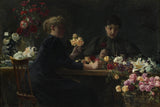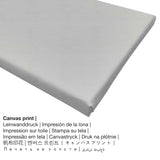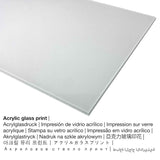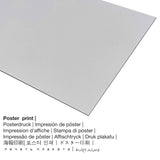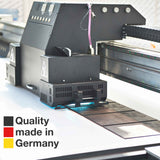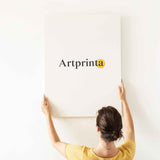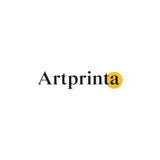Wilhelm Peters, 1894 - Ụmụ nwanyị nọ na tebụl ifuru - mbipụta nka mara mma
Ụtụ gụnyere. Mbupu gbakọrọ na ndenye ọpụpụ.
Nkọwa ngwaahịa nka
Ọrụ nka akpọrọ Ladies at a Flower-table kere site na Norwegian artist Wilhelm Peters. The over 120 a na-ese ihe mbụ dị afọ na nha: Ogologo: 96 cm (37,7 ″); Obosara: 142 cm (55,9 ″) Ekebere: Elu: 133 cm (52,3 ″); Obosara: 179 cm (70,4 ″); Omimi: 13 cm (5,1 ″). Mmanụ na kwaaji was used by the European artist as the technique for the work of art. What is more, this artpiece forms part of the National Museum nke Stockholm digital collection, which is Sweden's museum of art and design, a Swedish government authority with a mandatet o preserve cultural heritage and promote art, interest in art and knowledge of art. This ngalaba ọha artwork is included with courtesy of Nationalmuseum Stockholm & Wikimedia Commons.Creditline of the artwork: . Moreover, alignment of the digital reproduction is landscape and has a side ratio of 3 : 2, which implies that ogologo bụ 50% ogologo karịa obosara.
Iberibe nkọwa nka
| Iberibe aha nka: | "Ladies at a Flower-table" |
| Nhazi nka: | sere |
| Otu izugbe: | nkà nke oge a |
| Narị afọ nka: | 19th narị afọ |
| Afọ nka: | 1894 |
| Afọ nka: | 120 afọ |
| Agba na: | mmanụ na kwaaji |
| Akụkụ nke nka nka izizi: | Ogologo: 96 cm (37,7 ″); Obosara: 142 cm (55,9 ″) Ekebere: Elu: 133 cm (52,3 ″); Obosara: 179 cm (70,4 ″); Omimi: 13 cm (5,1 ″) |
| Ụlọ ihe ngosi nka / ebe: | National Museum nke Stockholm |
| Ebe ngosi nka: | Stockholm, Obodo Stockholm, Sweden |
| Weebụsaịtị nke ihe ngosi nka: | www.nationalmuseum.se |
| Akwụkwọ ikike nka: | ngalaba ọha |
| Site n'aka: | Nationalmuseum Stockholm na Wikimedia Commons |
Tebụl onye na-ese ihe
| aha: | Wilhelm Peters |
| Aha ndị ọzọ: | Peters Wilhelm, Wilhelm Otto Peters, Wilhelm Peters, Peters Wilhelm Otto |
| okike nke onye nka: | nwoke |
| Obodo onye nka: | Norwegian |
| Ọrụ: | onye na-ese ihe |
| Obodo obibi: | Norway |
| Nhazi nke onye nka: | omenkà nke oge a |
| Afọ ọnwụ: | 84 afọ |
| A mụrụ: | 1851 |
| Obodo amụrụ: | Oslo |
| Afọ nwụrụ: | 1935 |
| Obodo ọnwụ: | Drøbak |
Nhọrọ akụrụngwa ngwaahịa enwere ike
Anyị na-enye ihe dị iche iche dị iche iche na nha maka ngwaahịa ọ bụla. Nha na ihe ndị a bụ nhọrọ anyị na-enye gị maka nkeonwe:
- Mbipụta aluminom (aluminium dibbond): These are metal prints on aluminium dibond material with an outstanding depth. Its non-reflective surface creates a contemporary look. The bright parts of the artpiece shine with a silk gloss but without glow. Colors are vivid and luminous, the fine details of the print are crisp. This direct UV print on aluminium is one of the most demanded entry-level products and is a contemporary way to showcase art, since it draws focus on the image.
- Mbipụta kanvas: The printed canvas, which should not be mistaken with an artwork painted on a canvas, is an image applied directly on canvas fabric. It makes a sculptural look of three dimensionality. A canvas print of this work of art will provide you with the unique opportunity to transform your art print into a large size artwork like you would see in a real gallery. A canvas print has the advantage of being relatively low in weight, which means that it is easy to hang your Canvas print without the support of any wall-mounts. That is why, a canvas print is suitable for all kinds of walls.
- Mbipụta iko acrylic na-egbuke egbuke (nke nwere ezigbo mkpuchi iko n'elu): The acrylic glass print, often described as a print on plexiglass, changes an original artwork into wonderful décor and is a viable alternative option to dibond and canvas fine art prints. The major advantage of an acrylic glass fine art copy is that contrasts and details will be more identifiable with the help of the very fine tonal gradation.
- Poster (akwa akwa akwa): Our poster print is a UV printed flat canvas paper with a nice structure on the surface, that resembles the original version of the work of art. Please note, that depending on the absolute size of the poster we add a white margin of around 2-6cm around the artwork to facilitate the framing.
Banyere akụkọ
| Nkewa edemede: | mmepụta nka |
| Usoro mmeghari: | dijitalụ mmeputakwa |
| Usoro nhazi: | Mbipụta UV ozugbo (mbipụta dijitalụ) |
| Production: | arụpụtara na Germany |
| Stockdị ngwaahịa: | a na-achọ |
| Eji ngwaahịa emebere: | nchịkọta nka (mmeputakwa), ụlọ mmepụta nka nka |
| Nhazi: | nhazi odida obodo |
| Oke akụkụ onyonyo: | ogologo: obosara 3:2 |
| Nsonaazụ: | ogologo bụ 50% ogologo karịa obosara |
| Nhọrọ akwa: | acrylic glass print (nwere ezigbo mkpuchi iko), mbipụta akwụkwọ mmado (akwụkwọ kwaaji), mbipụta kanvas, mbipụta ọla (aluminium dibond) |
| Canvas dị n'elu ihe nrịbama (mbipụta kanvas) nha dị iche iche: | 30x20cm - 12x8", 60x40cm - 24x16", 90x60cm - 35x24", 120x80cm - 47x31", 150x100cm - 59x39" |
| Acrylic glass print (nwere ezigbo mkpuchi iko) nhọrọ: | 30x20cm - 12x8", 60x40cm - 24x16", 90x60cm - 35x24", 120x80cm - 47x31", 150x100cm - 59x39" |
| Ụdị akwụkwọ mmado (akwụkwọ kwaaji) dị iche iche: | 60x40cm - 24x16", 90x60cm - 35x24", 120x80cm - 47x31" |
| Nhọrọ nha mbipụta aluminium dibond: | 30x20cm - 12x8", 60x40cm - 24x16", 90x60cm - 35x24", 120x80cm - 47x31" |
| Nhazi nke nnomi nka: | enweghị etiti |
Ihe dị mkpa: We try our utmost to depict the art products as accurate as possible and to display them visually. Nonetheless, the colors of the printed materials, as well as the print result may diverge marginally from the presentation on your device's screen. Depending on the screen settings and the quality of the surface, not all color pigments can be printed as exactly as the digital version shown here. In view of the fact that all art reproductions are processed and printed manually, there might as well be slight variations in the size and exact position of the motif.
© Nwebiisinka nke | Artprinta.com

